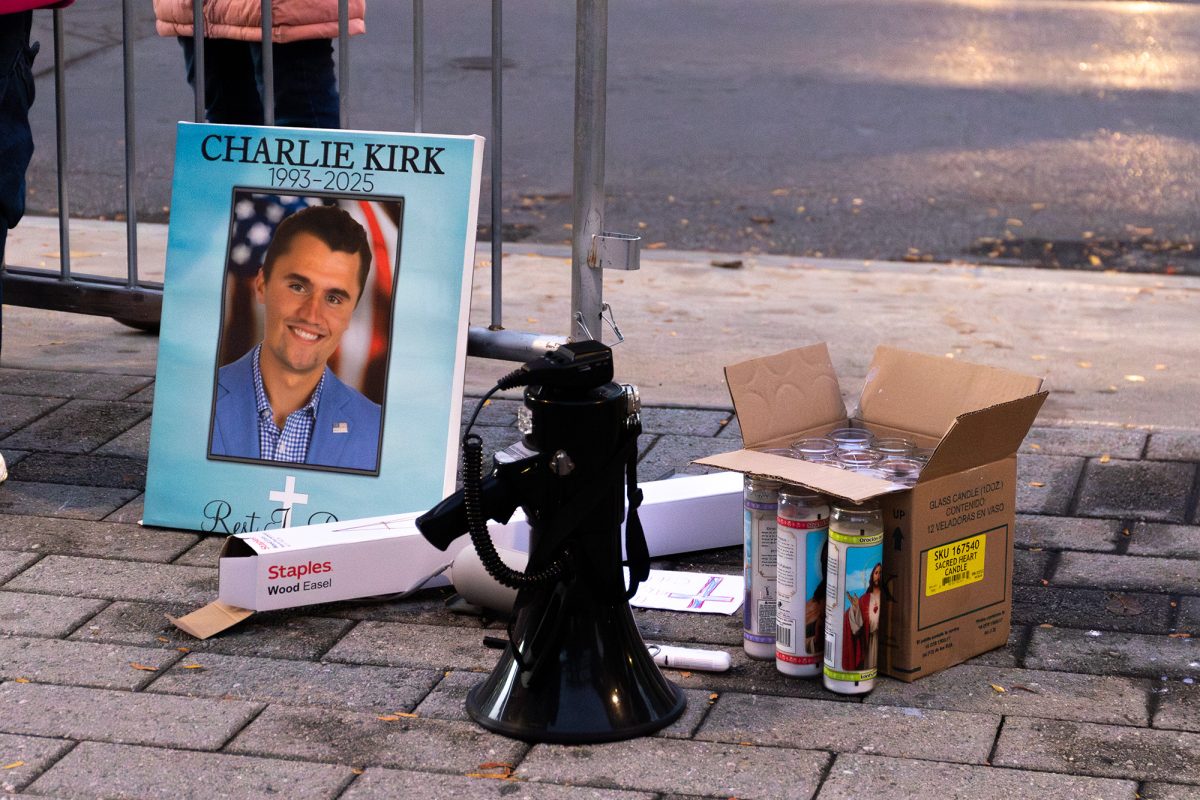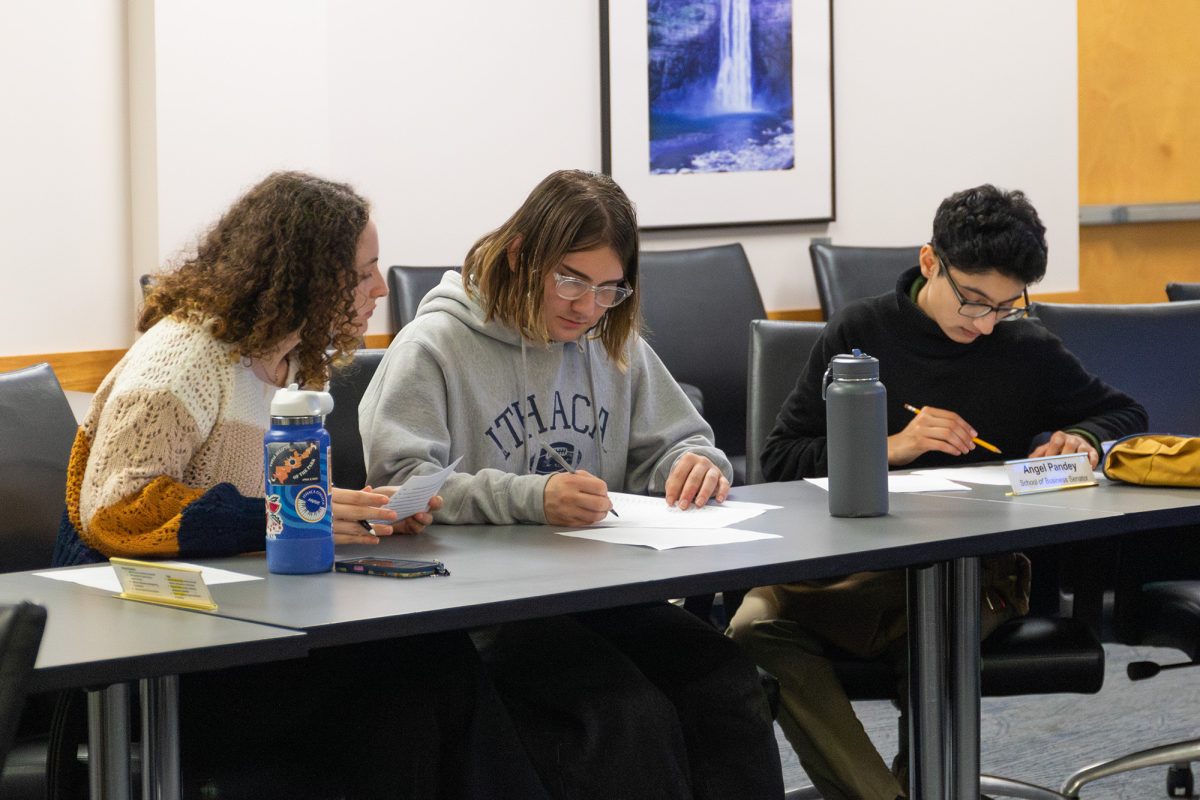Ithaca College President Tom Rochon held an all-college meeting March 5 to announce the administration’s plans for the college. The biggest of these plans is the “blue-sky” reimagining, which would involve extensive communication between the campus community and the administration about an ideal vision of the college.
During the meeting, Rochon also discussed ways the college plans to save money and increase affordability. He said these methods can include ways of diversifying revenue, such as building new student apartments, and reducing costs, such as budgeting for lower enrollment targets.
Editor-in-Chief Jack Curran spoke with Rochon about the details of the “blue-sky” reimagining, the possibility of new student apartments and other issues currently facing the college.
Jack Curran: Why did you invite students to the meeting?
Tom Rochon: A number of the potential initiatives around diversifying revenue — and certainly around reimagining the immersive residential campus experience — are ones in which student perspective and expertise can be very helpful in pointing us in solid directions.
JC: How do you expect the communication between students and the administration to go?
TR: I do believe on the “blue-sky” reimagining that I not just call for it and hope it spontaneously arises, so I picture for example the possibility of a speaker — I have no idea who — who might galvanize our thinking or open our minds to new possibilities. But the primary energy should come from inside. I hope there will be faculty discussion groups, staff discussion groups, student discussion groups and mingled discussion groups that might sometimes take on the whole topic and sometimes take on a specific slice of the topic, such as what would a residential housing community ideally be like.
JC: How would the Integrative Core Curriculum play into the “blue-sky” reinvisioning?
TR: I want to make a distinction here: The ICC was a result of a strategic plan. That means that we specifically at that time asked, “What aspects of Ithaca College need improvement, and should we work on in a strategic plan?” And the existing general-education program was widely recognized as being in need of great improvement. It was also recognized by our accreditor as being in need of great improvement. So the ICC stemmed directly from that.
The “blue-sky” reimagining would not start from worrying about what’s wrong or weak about Ithaca College. It would start from the ideal. What would be the best immersive learning community that we could possibly imagine? What would curricula be like? What would faculty-student relationships be like? How hard or easy would it be to travel between different schools? To try to actually put Ithaca College out one’s mind and just think about what would be the best, the most exciting, immersive educational experience that we could possibly imagine, just start describing. That’s the question of the reimagining.
JC: So this isn’t stemming from questioning any of the programs we currently have?
TR: No. Now what might come out of that, might be a reinforcement of things we have, it might be a complete repudiation of things we have, there might be something in IC 20/20 where you look at that ideal and go, “Wow, why did we do that?” That’s part of the excitement, all of those things are possibilities.
JC: Do you have any estimate of how long the “blue-sky” redesign would take?
TR: None. I’m very hopeful we can do something with this semester already. I know on the front end I’d like to get it launched, but I think we can’t even picture yet what the process should be like. If I just had to make a wild guess, I would say between 1 1/2 years and 2 1/2 years, but a lot depends on how good we are at creating opportunities for people to participate and then how much energy there is. The biggest variable is how quickly people converge on a certain number of core ideas, because it might be all over the place or there might be several powerful things.
JC: With the “blue-sky” reimagination and the changing specific department enrollment goals, is there the potential for eliminating faculty positions?
TR: Let me back up to what we’ve done with staff. Our general approach has been start early, a lot of analysis and spread this out over time. That approach proved itself by finding 36 open positions. Not all of them were open when we started, sometimes someone indicated that they were going to move on to another opportunity or retire and we were able to say, “Hey, we’re doing this analysis, and we realize we can capture this position.”
I think that developing more flexibility on enrollment targets in programs can have the same impact on capitalizing on faculty openings as they occur rather than actually not renewing a contract for a faculty member. And it’s even more true there, because most faculty have the option of doing several things within the college: they can teach within their major, they can teach allied courses outside of their major or they can teach in the ICC. So when it comes to the individual, when we’re examining better fitting applications to our program capacity, that doesn’t necessarily translate to a faculty job being there or not, it might instead translate to what is the faculty member teaching.
JC: Where would the money come from to build new off-campus housing?
TR: There’s a small number of possibilities, and all possibilities are on the table. One that I mentioned is, conceivably, we would do it in a partnership with a private developer. In a sense, we provide the market, the private developer provides the capital, or the money, and I’m not sure who provides the land, it could go either way.
Another possibility is that we borrow the money. After all, a new apartment complex would be revenue generating and would probably justify borrowing. And another possibility is that we use money from our operating balances just the way we use it to build things on campus, or fix electrical power outages, etc. In other words, there are multiple possibilities but not an infinite number of possibilities.
JC: How would college apartments be able to stay competitive with off-campus apartments, which in many cases are cheaper?
TR: There are cheaper ways to live off campus. Anything that we provide is likely going to have quality and convenience associated with it, but it would also be my goal that it would not be terribly expensive compared to existing off-campus opportunities. That’s part of what we would need to study: In a range of choices that students have, what part of the market can we best serve? The goal here is revenue diversification, but, after all, it’s also to give students a new choice or a new opportunity that they don’t have. It’s a win-win if we do it right.
JC: Does the college plan to raise wages for part-time faculty or have any kind of response to the unionization movement?
TR: Not as a response to the unionization movement, explicitly not as a response, because that actually would be an illegal thing to raise wages in response to a unionization movement. However, before we knew there was an organizing effort, we had already put into the budget a $100 per credit increase for part-time faculty and full-time faculty teaching an overload. The consideration of this was all completed before we knew anything about the organizing effort, and it was strictly because this was the standard year in which it would come up to happen.
JC: A number of people expressed concerns about asking current students for money while they’re still paying tuition. What response have you seen from students about IC Giving Day?
TR: Giving Day never had a single goal with respect to the number of dollars to be raised. The only goal was about participation and creating a sense of a student and alumni linkage that is loyal to giving back to the college. Students have a lot to gain from creating that culture of philanthropy. It’s very helpful when talking to alumni, who will be able to give more of course, to be able to say that students participated in this with real joy. The minimum gift was set at $10 (sic), and it was literally set at $10 because below that it turns out it costs more to process it than to receive it, but in principle, the organizers of Giving Day would have been happy to set the minimum gift at $1. It was about being part of something rather than raising money. I understand that students might feel that being asked to give money in addition to the big sacrifices they make to be able to afford the education seems insensitive — and if nothing else is proven today, it’s that I am so focused on student cost and affordability. But this was an effort to pitch it at a level that, in theory, anyone could participate in if they wished and be a part of a community.







